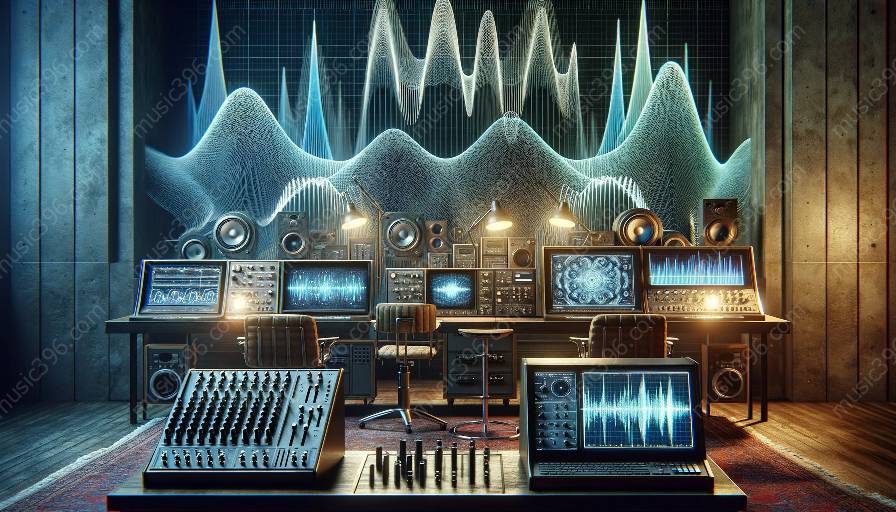Sound waves play a fundamental role in sound-based art and experimental music, incorporating the science behind sound waves and their interaction with music equipment & technology. Understanding the properties of sound waves and their application in the creation of unique auditory experiences enhances the appreciation of their artistic and scientific significance.
The Science Behind Sound Waves
Sound waves, as mechanical waves, are produced by the oscillation of particles in a medium, propagating energy through variations in pressure. When discussing sound waves in the context of art and music, it is essential to comprehend the wave nature of sound, including attributes such as frequency, amplitude, and wavelength. The relationship between these properties influences the auditory perception of sound, providing a scientific foundation for artistic exploration.
Frequency and Pitch
The frequency of a sound wave determines its pitch, with higher frequencies corresponding to higher pitches and vice versa. This relationship is pivotal in the creation of melodies and harmonies in music, as artists manipulate frequencies to evoke specific emotional responses and convey their artistic vision.
Amplitude and Volume
The amplitude of a sound wave dictates its volume, influencing the intensity of the auditory experience. By adjusting amplitudes, artists can craft dynamic compositions that encompass both gentle whispers and powerful crescendos, enhancing the expressive potential of sound-based art and experimental music.
Wavelength and Timbre
The wavelength of a sound wave contributes to its timbre, defining the unique quality and character of a sound. Through innovative use of wavelength modulation, artists can infuse their creations with diverse and immersive sonic textures, expanding the boundaries of artistic expression in sound-based art and experimental music.
Music Equipment & Technology
Sound waves are intricately intertwined with music equipment and technology, forming the essential components of musicians' creative toolkit. From acoustic instruments to cutting-edge digital sound processors, the interaction between sound waves and music technology allows for boundless experimentation and innovation in the artistic realm.
Acoustic Instruments
Traditional instruments, such as strings, wind, and percussion, harness the physical properties of sound waves to produce captivating musical expressions. The resonance and amplification of sound waves within acoustic instruments exemplify the direct influence of wave behavior on musical performance and composition.
Electroacoustic Instruments
Electroacoustic instruments, including synthesizers, samplers, and electronic controllers, manipulate sound waves through electronic means, offering artists unprecedented flexibility in shaping and manipulating auditory stimuli. These instruments extend the possibilities of sound-based art and experimental music, blurring the boundaries between traditional and contemporary sonic experiences.
Digital Signal Processing
Advancements in digital signal processing have revolutionized the manipulation of sound waves, enabling real-time transformation and manipulation of audio signals. From spectral processing to convolution reverb, the integration of digital technology with sound waves has opened new frontiers in the creation of immersive sonic environments and avant-garde musical compositions.
Creating Sonic Landscapes
Artists who explore sound-based art and experimental music are akin to sonic architects, sculpting intricate soundscapes that transcend conventional auditory experiences. By harnessing the science of sound waves and leveraging music equipment & technology, they craft immersive sonic environments that challenge perceptions and evoke profound emotional responses.
Interactive Installations
Sound-based art installations often utilize sound waves as the medium for interactive experiences, inviting viewers to engage with and explore the sonic landscape. Through interactive installations, artists merge the artistic and scientific dimensions of sound waves, fostering a dynamic connection between audiences and the expressive potential of sound.
Spatial Sound Design
Advances in spatial sound design leverage the spatial properties of sound waves, crafting three-dimensional sonic experiences that envelop listeners in immersive auditory environments. This multidimensional approach to sound-based art and experimental music transcends traditional stereo settings, offering audiences a heightened sensory engagement with the artistic manipulation of sound waves.
Transcending Boundaries
Sound-based art and experimental music defy conventional artistic norms, transcending boundaries of traditional composition and performance. By intertwining the science behind sound waves with music equipment & technology, artists expand the horizons of creative expression, ushering audiences into realms of sonic exploration.
Collaborative Innovation
Musicians, sound artists, and technologists collaborate in pioneering interdisciplinary projects, merging the precision of scientific inquiry with the boundless creativity of artistic expression. Through these collaborations, the convergence of sound waves, technology, and art gives rise to trailblazing works that challenge and redefine the boundaries of sonic creativity.
Sensory Immersion
Immersive experiences, facilitated by the integration of sound waves, technology, and art, transcend passive observation, inviting audiences to immerse themselves in the sonic realm. With sensory immersion, sound-based art and experimental music elicit visceral and unforgettable experiences that resonate on emotional and scientific levels, transcending the boundaries of traditional artistic expression.























































